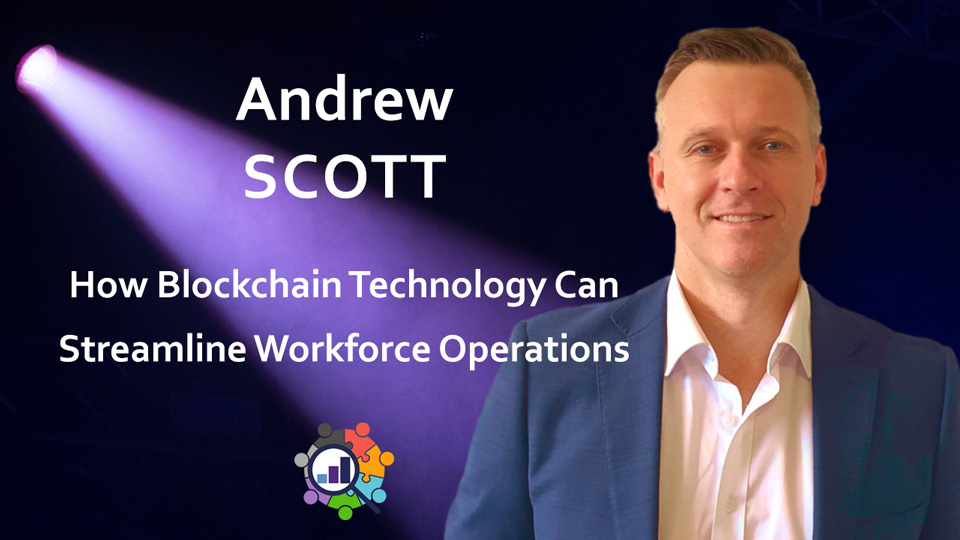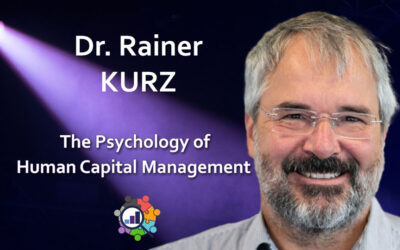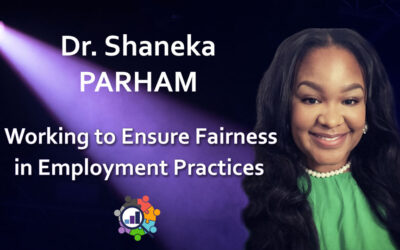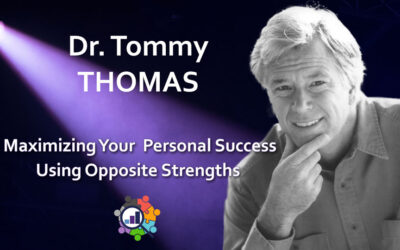A CykoMetrix Spotlight Production
Every week, the Spotlight shines on an amazing professional with a story to tell and lessons to teach. Welcome to the CykoMetrix Spotlight.
The following is an adapted transcript of the exchange between Sylvain Rochon, CMO at CykoMetrix as host, and Andrew Scott, change leader, innovator and business transformation specialist.
Sylvain Rochon: Welcome to CykoMetrix Spotlight. My name is Sylvain Rochon, I’m the Chief Marketing Officer at CykoMetrix, a company that is Software as a Service that measures people’s soft skills, values, effectiveness. We also measure the effectiveness of a team, team climate, counterproductive work behavior, all sorts of other parameters that allow a consultant, training company or staffing company to make great decisions, benchmark, train again, and continue development so that the staff at a company becomes better, develop their soft skills, become a more efficient and more cohesive group. That’s what we do.
Today in the spotlight. I am with Andrew Scott from Australia. He is an amazing person. We keep chatting about all sorts of stuff entrepreneurial and innovation but basically, he’s an Australian Human Resources Tech entrepreneur with over 20 years of experience leading organizational change and business transformation programs throughout the Asia-Pacific region. He has extensive experience across a broad range of industries. It’s given him a diverse view of good workforce practices and has allowed him to establish unique fit-for-purpose solutions to drive cross-industry innovation.
Just like me, he is a start-up entrepreneur. In his latest company, he has used blockchain technology to provide companies with the ability to securely verify employee records in real-time, reducing business risk and improving operational efficiency while giving employees control of their data. That is something that is extremely topical. We’ve been talking about this with other guests at certain points but Andrew here has built a solution that actually uses blockchain technology to handle these things. So, we’re going to be talking about this today, specifically how blockchain technology is being used to streamline workforce operations. Welcome to the spotlight, Andrew.
Andrew Scott: Thanks, Sylvain. Great to be here.
Sylvain: Absolutely. Now, most people have heard of blockchain because of cryptocurrency. That’s usually the gateway. More recently people have been hearing about NFTs and some of these other terms that are like they come from another language. Blockchain… I think it would be a good idea to define what it is. I’m going to let you, Andrew, explain what it is and why it’s not exclusive to currency and these other things. Then from there, we’ll go into your solution.
Andrew: Blockchain and, more broadly, distributed ledger technology is a way of recording a transaction or an event in a way that’s immutable. It can’t be changed, can’t be modified at all. So, it gives you a way of making a digital transactions, but having a record of that transaction that can be traced and is effectively a true transaction. So, similar to if you were handing someone a piece of paper, but you’re handing them a digital piece of paper that also transfers ownership of that piece of paper.
Sylvain: Good. So, it’s something that is invisible. It’s in the software, right? So, it’s not something we can touch or anything. So that’s why it’s a bit abstract for a lot of people that don’t understand this space. Now, the question I got… How does using blockchain innovatively change the world of privacy and workforce operations?
Andrew: I think one of the key shifts that we’ve got is in business today, most companies will own a set of data about the employee, whether that’s sitting in an HR information system or a learning management system or any of their corporate systems. What we’re doing is we’re putting control and ownership of that data back to the individual. So, ultimately, the individual is the owner of that data, whether it’s company data or whether it’s data that sits outside what the company wants to use. The individual owns it and then shares that with the company. So, what it does is it selectively allows the individual to control what information that is shared, but it also gives them the ability to revoke access to that content as well. So, if they leave employment, or if they no longer want your employer to have certain data, then they can revoke that and they still have full control over that, which they can also take to the next place. So, it’s reusable but it is fully owned by the individual and shared with third parties.
Sylvain: That’s exciting. So, can you give us some examples of different applications that can be put onto the blockchain… used for interaction between employee and employer?
Andrew: Yeah, absolutely. One of the key use cases that we’re coming across now is there’s a lot of external data that companies want to get access to, that’s really driving organization compliance. So, my professional licenses. Am I an electrician or not? It may be my education. Have I done the education? But is it also current? But also, then leading back into a range of other government data and identity data. So, it might be my driver’s license. Is it still current? Is it still valid? Am I authorized to do a task on-site? And so, what we’re starting to see is that mapping between your personal information that is happening outside of the organization linked back to requirements for your role and how we can verify that in real time, so that we know that you’re compliant right now, rather than you were compliant when we originally hired you. I think that the key difference is bringing this back into a space where it’s real-time compliance, rather than a set-and-forget approach, which a lot of companies take.
Sylvain: All right. So, typically, when there is some kind of certification as required to different things, you would have this external organization that will provide a certificate. Sometimes it’s on paper, sometimes, nowadays, it’s a PDF or something like that. And with the employee, I suppose, traditionally, you’d have to chase that down, right? As the employee, they have to track down, sometimes they have to pay a fee or something if it’s not up to date. I suppose it creates delays but that’s how we’re used to operating because that’s the way it is.
In practical terms, how does having that onto the blockchain make it easier to track? What is the difference in speed, for example, of actually tracking something like that?
Andrew: So, with any of the documents that you generally provide, I guess the first challenge is always going to be, is it true and accurate? What we find is, in most organizations, around 5% of the workforce is non-compliant at any point in time. That might just be because they forgot to renew something, or it could be because of fraud. So, the intentional or unintentional consequences will still apply within the organization. So, what we do is by having this recorded on the blockchain, what it does is it links that transaction back to the original issuer so you can verify that it’s true. But once it’s there, you can then generally verify it within a matter of seconds. So, you could have your entire… whether it’s employment history, your educational history, any of your employment data could be verified and allow you to get on-site or start working within a matter of minutes.
We did a study with a government organization here in Australia. What we found is it reduced the onboarding time for people by 99.6%. So, it took it down to minutes rather than days. So, the speed of transaction but also the security of the transaction makes a huge difference in how quickly we can move. That also flows onto the employee experience and general satisfaction about removing administration and reducing friction within the transactions between the employee and the employer.
Sylvain: That difference in timeline is sufficient to really make a difference whether or not a person is going to be hired.
Andrew: Absolutely.
Sylvain: The employers don’t have a lot of time to sit around, right? Sometimes, if anything is as equal and one has the certifications within a couple of minutes determined as valid and on the other hand, if he has to chase it down for a week, sometimes that’s going to be a difference maker.
Andrew: Absolutely.
Sylvain: The question that follows that though is how does the certificate or data or government ID or whatever it is… How does it end up on the blockchain? Is it the user him/herself that deposits or do you have to create partnerships with the certification organization or government so that they basically update dynamically and the certificate lives on the blockchain?
Andrew: We do it a couple of ways. One is using API Connections back to source systems so that we can automatically capture the data and then transfer it into a cryptographic format which is then stored on the blockchain. The other way is we have a customer portal where if we don’t connect directly with their system, they can go in and they can register and issue their credentials through their official account. So, there’s a lot of security that sits behind it, making sure that the issuer of the credential is authorized to do that. Then they send that to the individual.
So, it starts with the issuer, owning that data. I think this is where there’s also the importance that while the individual can revoke access when they share it, the issuer also has permissions and controls around the credentials as well, where they can revoke the credentials if they find something’s not right, or a registration has expired. So, those additional controls for the issuer also add that layer of security that it’s not the individual attesting to this. It’s coming from an authorized source.
Sylvain: That’s a good point because one of the typical characteristics of these decentralized ledgers, as you accurately called them, is that you have an audit trail of every modification, change and transaction. So, in the case you just described, for example, a person may have… let’s say they have a certification they have to renew every year… the blockchain would have proof of that renewal every year. It would be able to see the update. Presumably, if for whatever reason, the certification was, assuming there’s a connection with the issuer, there was a revocation at any point in time in there, there would be a trace of it, and the re-establishment and all that stuff. So, a person or an employer, for example, or even the employee himself that is curious about what happened over time, can probably delve into that and see what exactly happened. Is that correct?
Andrew: Yeah, absolutely. So, I can see the audit trail and the history. The credentials too can have an expiry date on them. So, if they are aging credentials, you can have them automatically expire. Our integration into different corporate systems then allows us to trigger notifications directly to the employer. So, if something happens to a credential, it’s revoked or it expires, the employer knows what’s happened and they get notified straight away, so the people aren’t doing work that they shouldn’t be doing, which ultimately keeps the company safe but also keeps the individual safe as well.
Sylvain: Yeah. People are notoriously forgetful, especially when it’s something that has to be done every year or every couple of years. People forget. I had some to renew or things like that. So, that’s very useful as far as a feature more than anything.
Now, we were talking a little earlier before we started recording this interview about how this could potentially be used to track and keep a record of a person’s psychometric profile, for employment practices, to keep track of their own progress and soft skills, and things like that. That is very personal information. Especially these days, the employer really is looking at soft skills to determine hiring, promotions, or lateral movements and things like that inside a company.
So how do you feel and how do you see this particular application onto the blockchain. Additionally, how can the addition of psychometrics inside the system also streamline workforce operations?
Andrew: So a lot of companies that are using psychometrics will bring that into a recruitment process and certainly, what we’re seeing is the overlap or the ability to bring this into a recruitment process to make sure that you’re vetting your people before you employ, and you can do it early in the process rather than finding out later that there are problems. So, bringing in as much robust data as you can is going to help in the recruitment process and in that decision-making process, whether that’s skills that have been attested from a previous employer or an assessment that they’ve done outside of the organization.
There’s a variety of different ways that you can get the data in there. But having a broader view of not just the technical qualifications of someone but also their experience, their behaviors, their skills, gives you a much richer view which allows you to look at the candidate in a very different way. I think this is where we’re now starting to move to, is taking a very different approach to how we recruit, how we look at people, and how we find a fit for our organization and our organizational culture, rather than just can the person do the job, and who’s got the most experience?
Sylvain: Absolutely. This is our focus as CykoMetrix, in fact. We do the measurement but it has to be useful. By useful, it means you’re measuring soft skills, sure, but not everybody is going to operate effectively in any team inside a company and in any culture. There’s such a thing as cultural fit. There is such a thing as subcommittee fit and team fit and things like that. If you want to talk about retention or attrition, if you do a proper fit when you’re doing your hiring, it’s to everybody’s benefit because the person’s happier, will stay there longer, will hopefully be put in the right positions with the right people where they can flourish. That’s really important. If you can have that on the blockchain and you can trace a person’s psychometric history, then you get to learn more about yourself and how you fit in, which teams, and what’s your favorite environment and culture. I mean, that really gets me going.
There are so many reasons why a person would leave a company that is unrelated to the person’s tasks. People don’t want to fluctuate from job to job constantly, at least the majority of people don’t enjoy that. They want to go someplace, enjoy themselves, and stay there for a few years.
You mentioned trends in this particular space, the psychometrics, and also using it for hiring. Is that something that you’ve seen primarily in Asia-Pacific or have you seen that also elsewhere?
Andrew: No. Certainly, I work with some global customers and what we see is probably more with customers that are more mature and customers that have well-established processes and are now at the point where they can start to bring in very different innovative processes. That’s across the industry. So, whether that’s within manufacturing, mining, finance, it doesn’t matter because, ultimately, you’re hiring people and you’re looking at behaviors and a range of things.
So generally, we find that it’s happening more broadly, certainly within the US, within Canada, and throughout Asia-Pacific. We see that quite a lot where there are elements of psychometric testing that’s bought into your recruitment process as well. We’re even seeing some recruitment companies that are starting to bring this in as part of their offering and integrate with psychometric assessment tools as part of that recruitment process simply because customers are now starting to see the additional value in having that data, and they’re seeing that as a differentiator for them in selling their products to the customers.
Sylvain: Now, finally, Andrew. Scott is your last name. If a person that’s watching this would like to interact with you or with this service, where should they go?
Andrew: The first place is probably our website which is vela.solutions. The other option is to connect with me on LinkedIn. I’m happy to connect, happy to discuss how we can support companies and what we can do.
Sylvain: Great. By the way, guys and gals that are watching, the link is in the description. It’s clearly marked. You don’t need to remember and freezeframe to figure out what he says. Just click on the link that is presented to you and go check it out. Have a conversation with Andrew. He’s a brilliant guy, an innovator like me. We love new ideas and solutions that really stick. Thank you so much for participating in this, Andrew.
Andrew: Thank you, appreciate your time.
About Andrew Scott – www.linkedin.com/in/andrew-scott-3a534832
Andrew is an Australian HR tech entrepreneur with over 20 years experience leading organisational change and business transformation programs throughout the Asia Pacific Region.
His extensive experience across a broad range of industries, has given him a diverse view of good workforce practices and has allowed him to establish unique fit for purpose solutions to drive cross industry innovation.
His latest company uses blockchain technology to provide companies with the ability to securely verify employee records in real time, reducing business risk and improving operational efficiency while giving employees control of their data.
About CykoMetrix – www.CykoMetrix.com
CykoMetrix is a leading edge combinatorial psychometric and human data analytics company that brings the employee assessment industry to the cloud, with instant assessments, in-depth analysis, trait measurements, and team-based reporting features that simplify informed decision-making around recruiting, training, and managing today’s modern workplace.



